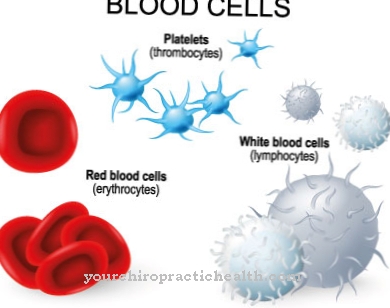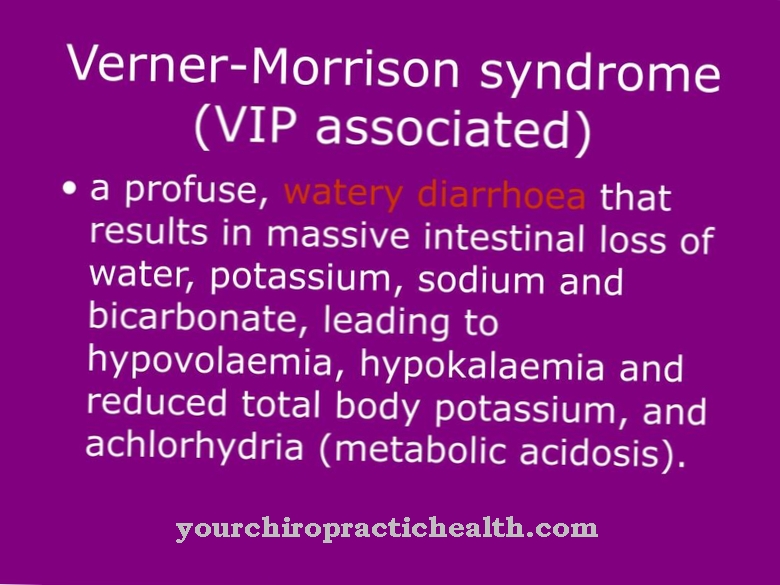A Atelectasis refers to an airless lung tissue. This is not an independent clinical picture, but rather a condition that results from another underlying disease. The symptoms can affect the entire lungs, in most cases, however, circumscribed sections of the lungs.
What is atelectasis?

© 7activestudio - stock.adobe.com
In atelectasis, either parts of the lungs or the entire lungs are evacuated. Translated from the Greek, the term means "incomplete expansion". This condition particularly affects the alveoli. These have a very important function, as the oxygen exchange takes place here.When the alveoli collapse, the area in question is no longer available for oxygen exchange.
Hence, atelectasis is a condition that needs to be taken seriously. Doctors differentiate between primary and congenital atelectasis. The acquired form is caused by another disease, while the congenital form only affects newborns or premature babies.
causes
The causes of congenital atelectasis are, for example, central nervous malfunctions, malformations or a surfactant deficiency, which can occur in premature babies. Surfactant is a mixture of water, proteins and fats produced by the lungs, which is used to reduce the surface tension of the fluid layer in the alveoli so that it can unfold. There are several forms of atelectasis:
- During compression atelectasis, the collapsed area of the lungs is squeezed off and thus prevented from unfolding. This could be due to a variety of causes, such as a tumor, an injury to the lungs or chest wall, a build-up of pus, water, or blood, or swollen lymph nodes.
- In contraction atelectasis, the cause of the lack of ventilation is scarring of the lungs, which is the result of a lung disease such as tuberculosis.
- In the case of microelectasis, the lung tissue in the corresponding area was too poorly supplied with blood, which can happen, for example, in a shock situation. As a result, it was unable to produce enough surfactant. The surface tension of the liquid pulls the lungs in the alveoli together at this point.
- Obstruction atelekase (subtype of resorption atelectasis) occurs when a branch of the lung is pinched off and the air that is trapped behind it is absorbed into the blood, for example by a tumor, a swallowed object or swollen lymph nodes.
You can find your medication here
➔ Medication for shortness of breath and lung problemsSymptoms, ailments & signs
With atelectasis, lung function is restricted because gas exchange can no longer take place. This reduces the oxygen level in the blood. The body now tries to compensate for this condition. It speeds up breathing and increases the heart rate. Due to the low oxygen level, the skin sometimes turns bluish.
The symptoms resulting from atelectasis depend, among other things, on the size of the affected lung segment. Another role is played by whether the atelectasis is acute or gradual. Furthermore, the individual causes shape the symptoms. If the atelectasis occurs suddenly, for example due to a blocked airway, it leads to severe shortness of breath and in some cases to sharp pain in the chest.
Slowly developing atelectasis, in which only small areas of the lungs are affected, causes only mild symptoms. These include shortness of breath and getting out of breath more quickly, especially during exertion. Large collapsed areas of the lungs, on the other hand, can lead to circulatory shock, in which blood pressure drops sharply and the heart beats very quickly.
Symptoms of congenital atelectasis often show up shortly after birth or in the first few hours of life. The skin of the affected premature babies turns bluish. You also breathe quickly, drawing in the areas between the ribs and above the breastbone as you inhale and increasing the movement of the nostrils.
Diagnosis & course
The doctor usually already bases the suspicion on the typical symptoms that indicate atelectasis. Usually the underlying disease also leads to the assumption that there is a pulmonary dysfunction. Breathing problems are generally expected in premature babies. Therefore, the baby's breathing, color of skin, heart rate, muscle tension, and reflexes are carefully observed immediately after birth.
The still immature lungs are one of the most common reasons for complications. The X-ray examination confirms the diagnosis. The degree of immature lung can also be determined. In the case of acquired atelectasis, it is important to identify the underlying disease. This is done by taking an anamnesis (detailed conversation with the person concerned) in order to ask him about the symptoms and known diseases. The lungs are then monitored.
If there is atelectasis, the breathing sounds are weakened. A muffled sound is heard when tapping the chest with your fingers. The additional x-ray examination again ensures the final diagnosis. Depending on the cause, for example a lung tumor, fluid or bruising in the chest, further examinations such as the examination of the blood, a computer or magnetic resonance tomography follow.
Complications
Atelectasis has different causes and can lead to different complications. On the one hand, atelectasis can lead to inflammation of the lungs (pneumonia). In the worst cases, this inflammation can spread over the entire body and thus lead to blood poisoning or sepsis. Sepsis can degenerate into septic shock.
This leads to a sharp drop in blood pressure, which leads to an insufficient supply of various organs with blood. This can lead to a failure of these organs. The lungs and kidneys are particularly susceptible. It also increases the risk of edema forming.
This retention of water in the lungs can become chronic and scarring (fibrosis) of the lung tissue can occur. As a result, the lungs can no longer expand properly, the affected person can hardly breathe and has difficulty breathing. The oxygen supply to the body is no longer guaranteed correctly, leading to what is known as central cyanosis.
In addition, the atelectasis constricts the pulmonary vessels, which can lead to stress on the right heart, which can be weakened as a result. In the course of the disease, the right heart becomes enlarged (right heart hypertrophy) and possibly the same heart fails (right heart failure). Those affected are severely restricted in their quality of life and their performance is reduced.
When should you go to the doctor?
Suspicion of atelectasis is a reason to see a doctor immediately. A number of warning signs can be used to determine whether this is the syndrome. Typical symptoms are difficulty breathing, sharp pain in the chest, and an accelerated pulse. Any of these symptoms should be evaluated by a health professional to rule out a serious cause or to diagnose the syndrome.
Medical advice is required at the latest when typical symptoms (circulatory problems, a strong feeling of tightness in the chest, a greatly increased pulse, etc.) occur. Patients with congenital atelectasis should consult their family doctor regularly. The same applies here: contact the emergency doctor at the first symptoms of an acute syndrome.
If the atelectasis is detected and treated at an early stage, serious consequences can be reliably avoided. If lung damage has already occurred and the patient collapses, first aid measures must be taken. The emergency services must be treated immediately in order to avoid serious consequences such as cor pulmonale or pneumonia of the lungs.
Doctors & therapists in your area
Treatment & Therapy
Treatment for atelectasis is primarily based on the causes. The aim is to restore lung function and ensure that the body is supplied with sufficient oxygen. In the case of a lung tumor, the tumor is usually removed by surgery. Surgical intervention is sometimes necessary for a pneumothorax in which air has entered the intercostal space, causing a section of the lung to collapse.
Mild forms, on the other hand, often do not require treatment. If there is a foreign body in the airways, it must be removed. In the case of a mucus plug, suction is performed. In congenital atelectasis, which is usually based on insufficient lung maturity, the lack of surfactant must be compensated for by giving the premature baby the substance as a drug. If the breathing problems are very pronounced, the baby is artificially ventilated.
Outlook & forecast
The prognosis of atelectasis depends on the underlying disease. If there is a foreign body in the lungs or airways, there is a good chance of recovery in most cases. The foreign bodies can be removed in one operation and breathing is possible again without being damaged. This depends on the size of the foreign body and the tissue it has damaged.
The healing path for pneumonia, however, is more extensive. In addition to drug treatment or inpatient treatment, it can be fatal. If it is not possible to supply the organism with sufficient oxygen, there is a risk of further complications that have a negative impact on the overall prognosis.
Heart problems can occur, which can lead to an acute health situation. In the event of a heart attack or stroke, the patient is at risk of lifelong impairment through paralysis or functional disorders. In addition, there is also a risk of premature death here. If the lungs are not functioning properly, artificial ventilation can be used.
If the lungs cannot be restored to the required extent, the patient can only be cured through an organ transplant. This is associated with numerous challenges and harbors a long road to recovery. If it is successful, everyday life must be adapted to the changed conditions. Nevertheless, it is possible to be largely symptom-free for many years.
You can find your medication here
➔ Medication for shortness of breath and lung problemsprevention
Acquired atelectasis cannot be prevented, only partially counteracted. Pregnant women suspected of having a premature birth are given a drug that stimulates the maturation of the unborn child's lungs. In addition, contraceptive agents are used to try to delay the birth.
Aftercare
The extent to which aftercare is necessary depends on the underlying disease. Basically, however, immunity does not build up even after healing. The complexity of the causes allows a renewed infection. If the typical symptoms occur, doctors will order an X-ray for diagnosis. Tapping on the chest can also sometimes clarify the situation.
If the initial illness caused foreign bodies in the lungs or the airways and no tissue was damaged during the treatment, there is no follow-up care. The patient is discharged and does not have to fear any further consequences. In many other cases, however, aftercare is of great importance.
Then the lungs are usually attacked so extensively that normal everyday life is no longer possible. Those affected can hardly cope with even small burdens. Since a final cure only takes place through a lung transplant, help is needed in everyday private and professional life.
Follow-up care aims to prevent complications by whatever means necessary. Since the atelectasis can be acquired and congenital, treatment methods must be adapted. Patients whose causes are not corrected need long-term treatment. Often you can remedy the symptoms with the help of medication. Regular visits to the doctor are then necessary.
You can do that yourself
People who suffer from atelectasis require extensive medical treatment. Usually an operation is necessary, which can be supported by those affected by taking care of themselves and following other medical guidelines.
It must also be ensured that the medication is optimally adjusted. A well-adjusted medication is particularly important when administering painkillers in order to relieve the patient of the symptoms and thereby also have a positive influence on the healing process. If unusual symptoms develop, the doctor must be informed.
Mild forms of alectase often do not require extensive treatment. It is usually sufficient to remove the foreign body from the airways and not to overwork the lungs for a few days to weeks. The congenital alectasis must be clarified by the pediatrician. Parents should watch the affected child closely and ensure that they are getting adequate air.
In the case of severe breathing problems, intensive medical treatment is required in any case. As this is also a considerable burden for the parents, therapeutic support should be sought. The doctor responsible can often put you in touch with a self-help group. There the parents can exchange ideas with other affected persons.


.jpg)
.jpg)
.jpg)






















